The thing is that some records just don't sound good.
The better your speakers are, the more you will hear it.
So this can become a bit of a problem.
I couldn't agree more.
Accurate speakers and or sound systems will only expose a bad recording. A system that makes everything sound great is not accurate. Over the many years of my professional career in audio and as a system and speaker designer, this problem is why you have to use the same source music over and over again when performing a listening test. Once you have become painfually
I couldn't agree more.
Accurate speakers and or sound systems will only expose a bad recording. .
Unfortunately my system is totally ruthless with bad recordings. I would say about 30% of my CD collection is of very poor production (especially the pop) there is nothing worse than buying a new CD and finding out the sound quality is appalling (I end up not even listening to it again) Why when I have gone to so much time and trouble to get my audio system to sound the best it can to the original (live or studio recording) do sound engineers make such a mess of the final production - it really gets my goat -and the compression they use, thats another story! I just assume they must have a serious hearing deficiency or don't give a Sh$$ and this is reason I am now forced to use a pre amp with some tone adjustment to make up for their lack of skill or laziness. Just listen to an early U2 recording, you may as well be listening to it through a phone.
Unfortunately my system is totally ruthless with bad recordings. I would say about 30% of my CD collection is of very poor production (especially the pop) there is nothing worse than buying a new CD and finding out the sound quality is appalling (I end up not even listening to it again) Why when I have gone to so much time and trouble to get my audio system to sound the best it can to the original (live or studio recording) do sound engineers make such a mess of the final production - it really gets my goat -and the compression they use, thats another story! I just assume they must have a serious hearing deficiency or don't give a Sh$$ and this is reason I am now forced to use a pre amp with some tone adjustment to make up for their lack of skill or laziness. Just listen to an early U2 recording, you may as well be listening to it through a phone.
I'm feeling the same pain. I can escape to my car for those recordings..at least some. I have a high power system in both of my vehicles, but road noise and car acoustics are more forgiving than my home two channel room. Recording quality has shaped my tastes in music for the last two decades. I still love rock, and fortunately, the musicians who record progressive metal have made huge improvements in sound Q. But when i want to listen for pure enjoyment, is jazz or classical.
A few recordings I use to see what my system is really capable of when recordings are done properly are: Zero Cult CD's, Art of harmony and Ikebana, these both give amazing width, space and 3 dimensional sound with punchy bass and very crisp treble. Eddie Reader first album 1994, and Eddie Reader -Angles and electricity. Angelis - first album with somewhere over the rainbow, (test for space, air and transparency) Sting -Soul cages in Q sound (speakers should disappear completely with this one) and an old favourite is Mariah Carey -Butterfly, especially the track "Fourth of july" this one's a test for sheer scale and dynamics.
Angus And Julia Stone Down The Way (just great to listen to by 2 excellent musicians) Conradin Kreutzer -Septet in E flat major - Consortium Classicum catalogue: C167881A,Great for testing violins and strings etc and a catchy tune.
-Any other suggestions for excellent test material welcome?
Angus And Julia Stone Down The Way (just great to listen to by 2 excellent musicians) Conradin Kreutzer -Septet in E flat major - Consortium Classicum catalogue: C167881A,Great for testing violins and strings etc and a catchy tune.
-Any other suggestions for excellent test material welcome?
I have several that I have used literally, for decades. As a young man I was a high end mobile audio installer. I built sound competition cars back in the days when sound quality was king, not boom. I was a car show judge and we had sanctioned material that every system was judged with. There were two sanctionnig bodies, IASCA and USAC. Both had official software CD's with various audio tracks and test tones, which I still use. I also use the Alpine Speed of sound reference disc, again, music and test tones, but I only ever use the music tracks, Tracks from Cliff Eberhart, Clair Marlo and Pat coil are all so burned into my head I can pick out problems or strong points of any system instantly. My two favorite classical reference discs are Chiller, a Telearc digital recording, conducted by Erich Kunzel, and the Monster Music disc released by Monster Cable in the 90's. Symphonic Metamorphosis and Fanfare for the Common Man are my two favorites. Moving away from reference compilations, one of my favorites is Dire Straits self titled debut album, what a fantastic recording that is. These are my primary materials when I am evaluating a system.
Last edited:
Unfortunately my system is totally ruthless with bad recordings. I would say about 30% of my CD collection is of very poor production (especially the pop) there is nothing worse than buying a new CD and finding out the sound quality is appalling (I end up not even listening to it again) Why when I have gone to so much time and trouble to get my audio system to sound the best it can to the original (live or studio recording) do sound engineers make such a mess of the final production - it really gets my goat -and the compression they use, that's another story!.
My solution is to have one hi-res system and then one I listen to casually. Headphones and good amps for great recordings and then something I listen to from the other room that sounds good on music I enjoy that was very poorly recorded.
No reason not to listen to a loudness war CD victim like Vulgar Display of Power.
My Mirage could be listened to in the sweet spot, but if I turned it up some things would sound better across the house.
Last edited:
There are a few different things that can cause recordings to sound bad and it's important these aren't confused. Amongst these are...
Compression can have a negative effect, possibly including noticeable overload. Compression in my opinion is likely to make a recording disappointing to listen to, but it's less likely that it will be unlistenable.
Artificial reverberation has been used for such things as masking a marginal vocalist. It can do this on many systems but on good speakers it doesn't work. The effect will stand on its own as a needless and possibly disappointing addition.
A poor mic, harmonic distortion and clipping can be more obvious but are also more likely to make a recording disappointing than unlistenable.
A recording that shows a heavy hand with an equaliser can sound even worse but this could be reduced with counter EQ.
In my experience the thing that is more often responsible for making recordings unlistenable is speakers. Resolution is not the cause. Linear distortions of the form typically produced by a speaker (not to exclude the room) can make a recording difficult to listen to. Their arbitrary nature (for a given system) can make some recordings sound OK and others not, and this may be as a result of the material and not the recording per se.
Another distortion which has been more recently hypothesised and may possibly have some bearing, is thermal modulation.
Linear distortions created on a recording tend to be more restricted and gradual which can make them less difficult to deal with.
An example recording, 'Runaway' by Del Shannon, is fraught with harmonic distortion. It typically sounds closed in, and band limited as if it may as well have been recorded in a bathtub yet this recording has a fair level of detail and nuance, and some parts can sound real enough to give the illusion of being there.
There can be a fair degree of difficulty in identifying the speakers as the culprits though. A problem can sound different when it is imposed on different recordings and it can take some time to isolate by ear, if it is even possible. Even when it is possible it can be just as difficult to know precisely what to do about it. When there is more than one problem it can be even harder to identify either.
Compression can have a negative effect, possibly including noticeable overload. Compression in my opinion is likely to make a recording disappointing to listen to, but it's less likely that it will be unlistenable.
Artificial reverberation has been used for such things as masking a marginal vocalist. It can do this on many systems but on good speakers it doesn't work. The effect will stand on its own as a needless and possibly disappointing addition.
A poor mic, harmonic distortion and clipping can be more obvious but are also more likely to make a recording disappointing than unlistenable.
A recording that shows a heavy hand with an equaliser can sound even worse but this could be reduced with counter EQ.
In my experience the thing that is more often responsible for making recordings unlistenable is speakers. Resolution is not the cause. Linear distortions of the form typically produced by a speaker (not to exclude the room) can make a recording difficult to listen to. Their arbitrary nature (for a given system) can make some recordings sound OK and others not, and this may be as a result of the material and not the recording per se.
Another distortion which has been more recently hypothesised and may possibly have some bearing, is thermal modulation.
Linear distortions created on a recording tend to be more restricted and gradual which can make them less difficult to deal with.
An example recording, 'Runaway' by Del Shannon, is fraught with harmonic distortion. It typically sounds closed in, and band limited as if it may as well have been recorded in a bathtub yet this recording has a fair level of detail and nuance, and some parts can sound real enough to give the illusion of being there.
There can be a fair degree of difficulty in identifying the speakers as the culprits though. A problem can sound different when it is imposed on different recordings and it can take some time to isolate by ear, if it is even possible. Even when it is possible it can be just as difficult to know precisely what to do about it. When there is more than one problem it can be even harder to identify either.
There can be a fair degree of difficulty in identifying the speakers as the culprits though.
Knowing that a speaker is rarely (if ever) perfect, it is then difficult to decide which compromise is right/good and which is wrong/bad.
They all sound different and my objective is usually to get the best out of the drivers when there is no compromise, and to get the minimum allowable performance for each aspects if there should be a compromise.
One simple minimum allowable performance for my current speaker is there should be no peak at SPL much louder than I need. I ran open input voltage with TDA2030A amplifier and I could listen to the tweeter or the woofer alone without fatigue.
The above is usually important if rock music is the primary recording to listen to. There is no other music genre imo that can give as much enjoyment as rock if produced properly (at "live" spl).
A problem can sound different when it is imposed on different recordings and it can take some time to isolate by ear, if it is even possible. Even when it is possible it can be just as difficult to know precisely what to do about it. When there is more than one problem it can be even harder to identify either.
Jazz is very easy to reproduce correctly by most speakers, but there is that "aspect" that is required to make jazz sounds at its best. I don't know what to call it, rhythm may be. So it is for me adequate for any speaker just to have jazz to sound wonderful, which is not difficult to do by ear (And this includes the bass roll-off performance its reverberation or its minimum frequency)
A good example. As a child I used to wonder whether it was possible to render a realistic pizzicato double bass riff (and wished I could make it happenJazz is very easy to reproduce correctly by most speakers, but there is that "aspect" that is required to make jazz sounds at its best. I don't know what to call it, rhythm may be. So it is for me adequate for any speaker just to have jazz to sound wonderful, which is not difficult to do by ear (And this includes the bass roll-off performance its reverberation or its minimum frequency)
I think there is a connection (even a partial one) between listener fatigue and a smooth in room response. It seems the more of the harmonics of a note I can hear at the right levels, and in balance with other notes, the more I'll let go...and then the more (again) I'll hear.
Harmonic distortion just doesn't cause me the same problems.
Allen and Jay, you have both touched on great topics. I have been fortunate enough to spend a bit of time in recording studios in years past, and Allen you are dead on with the deficiencies in a lot of recordings. So many studios over compress the recording that they kill the life in the music, but that's not distortion or frequency response related. Some recordings you just have to wonder what happened; referring to the 1986 album from GTR, a "supergroup" started by Setve Hackett and Steve Howe, former Yes and Genesis guitarists. It literally sounds like someone put a mic next to a vinyl lp while it was playing to record it. It's loaded with static and has zero dynamic range. It is the only unlistenable recording I have in my library. But there are other recordings that were mixed poorly, I'll use Queensryche's album Operation Mindcrime for example. It's and excellent album, but it is a recording that will fatigue you. Specifically because the mid range is too hot, especially the snare drum. The bass guitar is recorded well, nice and punchy, but the kick drum is flat. This album is hot an every system I've ever played it back on. Great content, and parts of it sound good, but that snare drum will peel your face off. While I agree that music types like Jazz lend themselves well to higher sound quality, I think that the producers, engineers and musicians actually pay more attention to the quality of the final product. Jay, I agree that we always make a compromise because of the lack of a "perfect" speaker, and so do the recording studios, which brings me to my next point. I've been there from start to finish through the process of making an album. We were in three different studios, on for recodring vocals and instruments, one for mixing, and another for mastering. The overall sound quality from control room to control room was a real eye opener. We mixed at Step Bridge Sudios in Santa Fe, New Mexico, a studio that has a few grammies in on shelf. I didn't want to leave their booth it was so sweet in there. We brought the monitors from the studio in Las Vegas to Santa Fe(A brand I was importing from Germany at the time), and they sounded better than I have ever heard them. And this difference in response and quality astounded me. Now I can't listen to music without thinking about what the enginer was listening to when they mixed and mastered the album. The equipment this work is done on will shape the sound of the final product, meaning playback in the control room. Some have subwoofers, some do not. Some use Yamaha NS-10M monitors (A huge number), and other do not. We are always going to be subject to the artist, producer and engineers interpretation of what every instrument should sound like. The more they eq and process, the more they are influencing what we hear. All we can do as audhiophiles is try to assemble components and speakers that playback only what the source supplies...but isn't that why we are on this forum in the first place? 
Just to clarify for the benefit of those are not familiar, linear distortions include things such as frequency response and group delay. Though it is relatively easy to produce a speaker with a flat response, if you toss it in a room you'll likely be subjected to a multitude of complicating reflections and issues of diffraction. The main problem with this as I see it is that this acoustic environment will throw off the frequency response in narrow bands, and introduce quantities of excess group delay.
Logically this issue can't be fully undone by electrical means, including tweaking the crossover. It is usually the best not to even try, though it can be difficult to identify sometimes just whether a given problem is of this nature or not without measurements.
Certainly this could lead a mixer to want to dial back or emphasise a track, and for the wrong reasons so unless they are expected to be an acoustician as well I'd find it hard to point the finger directly at them where the speakers are less than perfect. The old rule of thumb 'if you're not certain about the need to EQ, leave it alone' is probably more true than an imperfect pair of human ears might be ready to believe...but at least most electronic EQ tends to be more gradual than the issues a speaker might produce.
Logically this issue can't be fully undone by electrical means, including tweaking the crossover. It is usually the best not to even try, though it can be difficult to identify sometimes just whether a given problem is of this nature or not without measurements.
...and a sudden (high Q factor) issue like this over a small range of frequencies could make a particular track or instrument harder to listen to, harder to hear, or harder to identify... despite the speaker sounding reasonably well balanced or measuring well when measurement smoothing is applied (to make it focus on, say, 1/3 octave bands).The equipment this work is done on will shape the sound of the final product, meaning playback in the control room.
Certainly this could lead a mixer to want to dial back or emphasise a track, and for the wrong reasons so unless they are expected to be an acoustician as well I'd find it hard to point the finger directly at them where the speakers are less than perfect. The old rule of thumb 'if you're not certain about the need to EQ, leave it alone' is probably more true than an imperfect pair of human ears might be ready to believe...but at least most electronic EQ tends to be more gradual than the issues a speaker might produce.
Last edited:
It's and excellent album, but it is a recording that will fatigue you. Specifically because the mid range is too hot, especially the snare drum. The bass guitar is recorded well, nice and punchy, but the kick drum is flat. This album is hot an every system I've ever played it back on. Great content, and parts of it sound good, but that snare drum will peel your face off.
Vic Coppersmith-Heaven used to mic all of his productions like this. On vinyl the highs were peeled off by the third listen. On CD or flac download it's bright even today with a kind remaster.
The old rule of thumb 'if you're not certain about the need to EQ, leave it alone' is probably more true than an imperfect pair of human ears might be ready to believe...but at least most electronic EQ tends to be more gradual than the issues a speaker might produce.
Agreed!
Angus And Julia - Stone Down The Way
Yep, that's a nice and very good recording.
A good recorded electronic album: Actress - R.I.P.
When designing speakers it is a balancing act: depending on the recording some will sound with too much bass and others with too much highs.
But when most of the good recordings sound balanced with natural voices and nothings annoys me, I'm happy
Sorting out this balancing act is done by playing lots of random songs with foobar, so all kind of music passes.
Regards,
Danny
I'd need to ask you how you're approaching this, but I'll give some general information.
Firstly though, there is technically no such thing as RMS Watts. The term is simply Watts. The usage of RMS Watts has come about I suspect because the term Watts is widely abused particularly in audio, as power handling seems to be an overrated thing (no pun intended ). When I use the term Watts myself, I mean Watts in its simplest and true form, unless I state otherwise.
). When I use the term Watts myself, I mean Watts in its simplest and true form, unless I state otherwise.
RMS, or root mean square refers to the way that AC is converted to it's equivalent of DC in so far as the equivalent DC voltage that would produce the same amount of heat into a load as, say, a sinewave would. RMS can be applied to Voltage or current, and will be 0.707 of the peak voltage. The normally significant ways to look at a sine wave (for different purposes of course) is for example: the peak Voltage, the peak to peak Voltage, or the RMS Voltage.
When I am interested in building an amplifier and want to know the required capabilities, I'll watch the music on an oscilloscope as I have learned to distrust multimeters at frequencies other than the mains frequency where they're usually designed to work. Then I'll note the peak voltages and study the speaker's impedance curve and impedance phase, so that I can derive the supply rails, current needs, and power.
For a simple operation this can be brought down to applying a single sinewave signal and measuring it with a multimeter at the speaker, or amp terminals, whichever is needed.
If you can tell me what you're trying to do, and how, I'll give you the formulas and methods.
Firstly though, there is technically no such thing as RMS Watts. The term is simply Watts. The usage of RMS Watts has come about I suspect because the term Watts is widely abused particularly in audio, as power handling seems to be an overrated thing (no pun intended
RMS, or root mean square refers to the way that AC is converted to it's equivalent of DC in so far as the equivalent DC voltage that would produce the same amount of heat into a load as, say, a sinewave would. RMS can be applied to Voltage or current, and will be 0.707 of the peak voltage. The normally significant ways to look at a sine wave (for different purposes of course) is for example: the peak Voltage, the peak to peak Voltage, or the RMS Voltage.
When I am interested in building an amplifier and want to know the required capabilities, I'll watch the music on an oscilloscope as I have learned to distrust multimeters at frequencies other than the mains frequency where they're usually designed to work. Then I'll note the peak voltages and study the speaker's impedance curve and impedance phase, so that I can derive the supply rails, current needs, and power.
For a simple operation this can be brought down to applying a single sinewave signal and measuring it with a multimeter at the speaker, or amp terminals, whichever is needed.
If you can tell me what you're trying to do, and how, I'll give you the formulas and methods.
And if you are asking about the power handling capabilities of a speaker driver there are two types, power thermal or electrical, and displacement limited or acoustic power handling. Electrical power handling is the amount of electrical energy the voice coil can handle before it overheats; overheating can cause either an open circuit, or a short circuit. Displacement limited is the power handling that is directly related to the speaker suspension, and the enclosure type. When you exceed displacement limited power handling, a speaker can hit bottom of voice coil travel and damage the voice coil. In some cases, a surround can tear, but you will hear audible distortion or popping when you've exceeded this limit. I believe AllenB has given a perfect description of what RMS means. A speaker manufacturer will spec power handling in terms of power thermal, displacement limited handling is a function of the driver's Xmax and the enclosure. Here is a link with the equations (and a calculator) you need to calculate power handling of a loudspeaker:how does one calculate the RMS power handling?
Closed Subwoofer Box Equations Formulas Design Calculator Par Maximum Displacement Limited Linear Power Output
The Thermal Power Handling of speakers is generally stated for different conditions. Some good (and honest) manufacturers often give 3 max power ratings.
The highest being the peak transient power.
This peak transient is sometimes the only one stated by the bad (or less than honest) speaker manufacturer.
I have two 8ohms Celestion drivers inside my Tannoy B950.
From memory each has a continuous no damage rating of ~300W for a total of 600W.
The peak rating for the speaker is 1200W and the recommended amplifier rating is 1000W to 2000W into 4ohms.
The highest being the peak transient power.
This peak transient is sometimes the only one stated by the bad (or less than honest) speaker manufacturer.
I have two 8ohms Celestion drivers inside my Tannoy B950.
From memory each has a continuous no damage rating of ~300W for a total of 600W.
The peak rating for the speaker is 1200W and the recommended amplifier rating is 1000W to 2000W into 4ohms.
Last edited:
trying to learn
I'll take your suggestion Alan and post what I have.
The box is about 36 high 10 wide 10 deep. My son has fried so far three tweeter coils. I would like to replace the TC90TD5B tweeter with something as good that can handle some real power but I don't understand crossovers, I have a ways to go learn it.
I tried a Dayton Audio DC28F-8 1-1/8" Silk Dome Tweeter 275-070
Specifications: • Power handling: 50 watts RMS/100 watts max • VCdia: 1.14" • Le: 0.09 mH • Impedance: 8 ohms • Re: 5.5 ohms • Frequency range: 1,300-20,000 Hz • Fs: 637 Hz • SPL: 89 dB 1W/1m • Qms: 0.82 • Qes: 0.9 • Qts: 0.43 • Dimensions: Overall diameter: 4.33", Cutout diameter: 2.72", Depth: 1.54" • Replacement diaphragm 275-072.
It doesn't sound good.
The Morel MDT-20 from what I have read is no longer made.
Why is the woofer crossover different when a different tweeter is used?
perhaps some tweeter and crossover recommendations.
The amp is a dual mono BrianGT chipamp.
Thank You
I'll take your suggestion Alan and post what I have.
The box is about 36 high 10 wide 10 deep. My son has fried so far three tweeter coils. I would like to replace the TC90TD5B tweeter with something as good that can handle some real power but I don't understand crossovers, I have a ways to go learn it.
I tried a Dayton Audio DC28F-8 1-1/8" Silk Dome Tweeter 275-070
Specifications: • Power handling: 50 watts RMS/100 watts max • VCdia: 1.14" • Le: 0.09 mH • Impedance: 8 ohms • Re: 5.5 ohms • Frequency range: 1,300-20,000 Hz • Fs: 637 Hz • SPL: 89 dB 1W/1m • Qms: 0.82 • Qes: 0.9 • Qts: 0.43 • Dimensions: Overall diameter: 4.33", Cutout diameter: 2.72", Depth: 1.54" • Replacement diaphragm 275-072.
It doesn't sound good.
The Morel MDT-20 from what I have read is no longer made.
Why is the woofer crossover different when a different tweeter is used?
perhaps some tweeter and crossover recommendations.
The amp is a dual mono BrianGT chipamp.
Thank You
Attachments
-
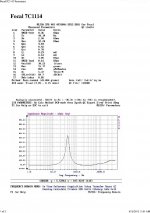 Focal 7C1147 Parameters-001.jpg204.4 KB · Views: 575
Focal 7C1147 Parameters-001.jpg204.4 KB · Views: 575 -
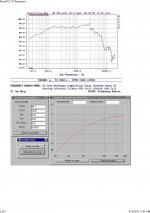 Focal 7C1147 Parameters-002.jpg193.3 KB · Views: 568
Focal 7C1147 Parameters-002.jpg193.3 KB · Views: 568 -
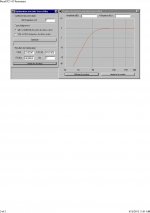 Focal 7C1147 Parameters-003.jpg91.8 KB · Views: 557
Focal 7C1147 Parameters-003.jpg91.8 KB · Views: 557 -
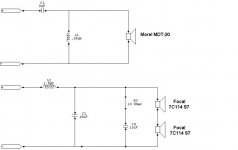 Morel.jpg30.3 KB · Views: 564
Morel.jpg30.3 KB · Views: 564 -
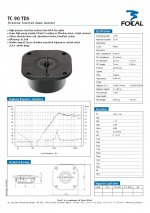 TC90TD5-001.jpg418.7 KB · Views: 563
TC90TD5-001.jpg418.7 KB · Views: 563 -
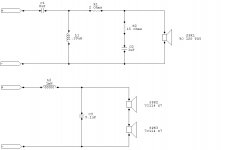 TC120.jpg58.6 KB · Views: 261
TC120.jpg58.6 KB · Views: 261 -
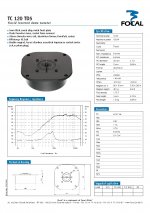 TC120TD5-Speaker.jpg384.8 KB · Views: 240
TC120TD5-Speaker.jpg384.8 KB · Views: 240
- Home
- Loudspeakers
- Multi-Way
- Introduction to designing crossovers without measurement